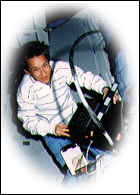Conference Schedule
FAQ
Program
-Welcome
-Introduction
-Pre-Program
-Workshops
-Keynote
-Technical Sessions
-Posters
-CEU Hours
-Classified Session
-Technical Tours
-Social Tours
-Registration
-Hotel Floor
Abstracts
Exhibitors
Pecora Award
Business Meetings
Sponsors
Committees
-Steering
-ISPRS
Conference Hotel
Keynote Presentation / Pecora Awards
Tuesday, November 12
1:00 pm to 3:00 pm
Room: Grand Ballroom I, Second Level, Tower Building
Opening Remarks:
James A. Sturdevant, U.S. Geological Survey,
Ellen G. Engleman, RSPA-DOT, and
John Trinder, ISPRS
 Earth Imaging from Space: New Actors, New Sensors, Better Products, and a Brighter Future?
Earth Imaging from Space: New Actors, New Sensors, Better Products, and a Brighter Future?
Gérard Brachet, Centre National d'Etudes Spatiales
Earth imaging from space has seen a multiplication of new systems operating both in the government sector (CNES, CSA, ESA, ISRO, NASA, etc.), and in the private sector (Space Imaging, DigitalGlobe, Orbimage, ImageSat). These provide services to both the science community and the operational applications users. After many years of development and market research, the Earth imaging industry has finally found its proper place and market, or is it still in its "trial and error" period? The verdict is not certain, but progress in sensor design, efficiency of system operation, and in product generation and delivery to the customer have enlarged the market base and penetration of satellite-based remote sensing technology worldwide. Although sensor performance may seem to be the driving factor, with high ground-resolution images now available to the civilian market, it is a combination of these high sensor performances and much improved overall service to the user community that is enlarging the market base. In parallel, new products generated from the most recent new sensors onboard NASA and other space agencies' spacecraft contribute greatly to our improved understanding of our planet's physical and biogeochemical environment. A review of these new sensors and their relations to market enlargement, as well as to Earth science research, shows that the present combination of cooperation and competition worldwide is indeed a good recipe for progress.
 Turning a Great Idea Into Real Science and Applications
Turning a Great Idea Into Real Science and Applications
Mary Cleave, NASA
Viewing the Earth from space was a truly inspired idea. But like all great ideas, this one has taken a lot of work to realize its full potential. NASA, USGS, and others have worked hard since the days of ERTS-1 to ensure Earth observation could be fully exploited for science and applications. This has required a focus on calibration and validation, and on expanding the spatial, temporal, and spectral coverage in scientifically useful ways. And it has required the formation of a web of commercial, interagency, and international partnerships with both suppliers and users of Earth remote sensing data. We have demonstrated the vast utility and potential of the view from space. It remains for us to help remote sensing products become ubiquitous in the economy and in societal decision-making generally.
Presentation of Pecora Awards
The William T. Pecora Award is presented annually by the Department of the Interior (DOI) and the National Aeronautics and Space Administration (NASA) to recognize outstanding contributions by individuals or groups toward the understanding of the Earth by means of remote sensing. We are pleased to present the 2001 and 2002 Pecora Awards as part of the Opening Keynote Session of this conference.
The Pecora Award was established in 1974 to honor the memory of Dr. William T. Pecora, former Director of the U.S. Geological Survey and DOI Under Secretary. Dr. Pecora was a motivating force behind the establishment of a program for civil remote sensing of the Earth from space. His early vision and support helped establish what we know today as the Landsat satellite program. The Award consists of a citation and plaque that are presented to each recipient by representatives from DOI and NASA. The name of each recipient is also inscribed on permanent plaques that are displayed by the sponsoring agencies.
 Copyright © 2001 American Society for Photogrammetry & Remote Sensing
Copyright © 2001 American Society for Photogrammetry & Remote Sensing
5410 Grosvenor Lane, Suite 210, Bethesda, Maryland 20814-2160
URL: http://www.asprs.org/
Maintainer: Pecora Committee
Last Update: September 15, 2002
